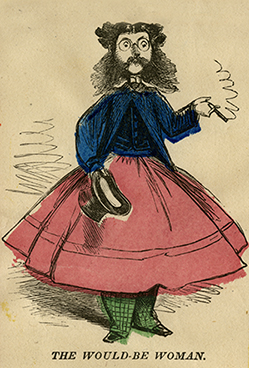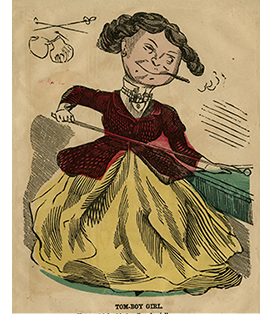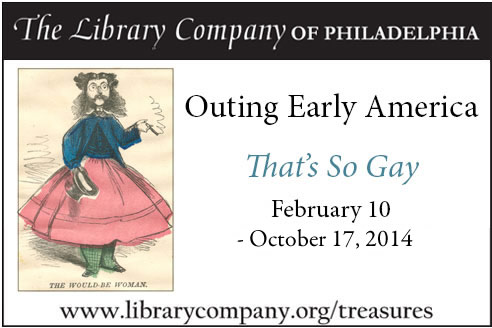 There is gay history on our shelves – even though we cannot know whether a person who lived in the past would be considered lesbian, gay, bisexual, or transgender today.
There is gay history on our shelves – even though we cannot know whether a person who lived in the past would be considered lesbian, gay, bisexual, or transgender today.
Individuals took part in same-sex relationships, wrote poems and novels celebrating such relationships, deviated from gender norms, and suffered for transgressive behavior in ways that are well-documented in the historical record. In the 19th and early 20th centuries, comic valentines provided an unsubtle way to ridicule people for their personal traits and behaviors. Sent anonymously, many of these caricatures and the accompanying verses poke fun at people’s failure to conform to gender norms. For men, comic valentines identify long hair, vanity, and unwillingness to serve in the military as effeminacy. Such men often were labeled “fop” or “dandy.” For women, wearing trousers, participating in “masculine” activities, and involvement in the suffrage movement could lead to being labeled a “tomboy.” The accompanying verse often suggested that an effeminate man or a masculine-seeming woman would fail to attract a mate of the opposite sex. Meant to be offensive, such suggestions may have missed the mark entirely for some of the recipients. The text on The Would-Be Woman says it all: “Some chaps are seen / For crinoline / By Nature's hand adapted; / No woman's love / To such is "guv," / Their hearts are never tapped at.”
 The 2014 exhibition That’s So Gay: Outing Early America seeks to show that – as with the African Americana and Women’s History Collections – --the abundance of resources documenting the subject in the collections of the Library Company merely awaits scholars who will shine a light on them. To paraphrase the late gay activist Harry Hay (1912-2002), history knows more about gay people than it knows it knows.
The 2014 exhibition That’s So Gay: Outing Early America seeks to show that – as with the African Americana and Women’s History Collections – --the abundance of resources documenting the subject in the collections of the Library Company merely awaits scholars who will shine a light on them. To paraphrase the late gay activist Harry Hay (1912-2002), history knows more about gay people than it knows it knows.
